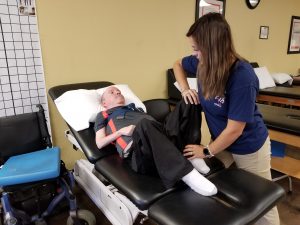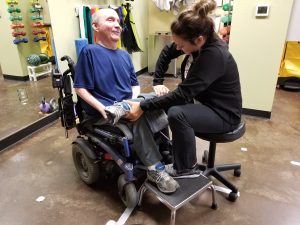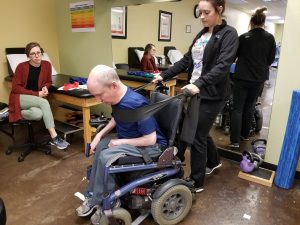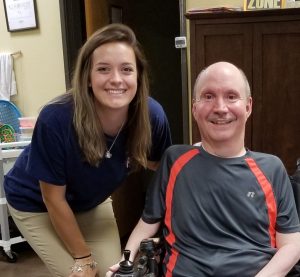Letting Physical Therapy Students Work With SMA Patients

Students must perform multiple clinical rotations before they graduate PT or PTA school. When students come into our outpatient clinic, they are exposed to a wide variety of diagnosis. One that always baffles them is SMA. In most cases. SMA is briefly taught about in school, because physical therapy for SMA patients has only recently started to become more widely used. Because of this, other diagnosis that are more commonly treated with physical therapy tend to be focused on. I usually have each student research what SMA is prior to our patient coming in, so they can become somewhat familiar with the diagnosis.


We have had several students that have worked with our patient who has SMA, Michael Morale. There are multiple reasons why I enjoy having students work with Michael. Initially, when someone sees a patient using a wheelchair in an outpatient setting, it can be intimidating, especially if it is your first clinical rotation. Michael is always willing to educate about SMA and open to having students work with him through his treatments. Michael always tells the students “I’m not a china doll. You’re not going to hurt me.” This simple statement is one that always makes students more comfortable and helps them to understand that just because he is in a wheelchair, it does not mean that they will hurt him the second they touch him.


Becoming comfortable while treating a patient with SMA can help produce a higher confidence in treating other less common diagnosis. Confidence allows the student to become creative and more specific with their types of treatment. Students must work within his plan of care, while considering what he is physically able to do, to come up with the most efficient and effective treatments. Each patient with SMA will present differently, so becoming familiar with the diagnosis and the physical tendencies that come along with it will be beneficial when SMA patients are more commonly seen in physical therapy.


======================== Student Perspective ========================

In my program, we only learned about SMA during pediatric lessons, but not as much for adults. So when I found out I’d be working with Michael, I was intimidated by his diagnosis, but interested in working with him. I learned so much from Michael & Emily about how to get creative with workouts for patients with SMA. Not all patients are at the level as Michael, but he gave great feedback which helped me out as a student tremendously, especially when it came to his manual therapy. I learned the best way for Michael to be transferred from his wheelchair and mat, bed mobility, and how to best perform his manual treatments. I greatly appreciate the opportunity to work with Michael, and believe it will help me in my career!
======================== Patient Perspective ========================

Before going on permanent disability in 2010, due to spinal muscular atrophy, I was a faculty member and college instructor for 2 colleges in Dallas County. During my 18 years of teaching, I learned how important it was to not only make learning fun, I tried to share my experience to each and every one of my students. Since beginning my physical therapy in October 2017, I’ve had the pleasure of working with 2 of the best physical therapists. Dr. Laura Cifre and Emily Jones have worked extremely hard in helping me to achieve my goals. During these past 2 years, I’ve had the privilege of working with some of Laura’s and Emily’s PT students while they complete their clinical rotations. Knowing that PT students only get a brief overview as to what SMA is, now that so many of us are on active treatment for our disease, which recently became available in the past 2 years, working with Laura’s and Emily’s students give me the opportunity to further educate them regarding this neuromuscular disease. Before working with any of the students, I explain what SMA is, and I try to ease their minds with regards to any questions or fears that they may have. By answering any questions that they may have before we begin, my hopes were that these students feel more comfortable and willing to work with SMA patients. Every student that I’ve worked with over the past 2 years, have not only demonstrated their knowledge in PT, they’ve also gained valuable experience with working with SMA patients. While I fully understand the importance of learning these skills in the classroom, in my opinion, nothing is as important as hands-on experience. Students take what they’ve learned regarding the theory of physical therapy, and then put this theory to use during their rotation. By gaining valuable hands-on experience, hopefully, this knowledge will allow them to help other SMA patients if they see them during their working careers. I’m very thankful that Laura and Emily have given me the opportunity to work with their students.



